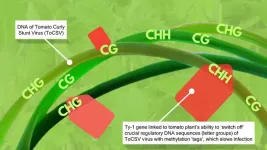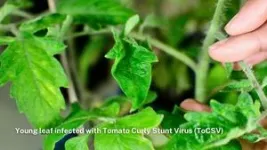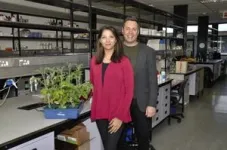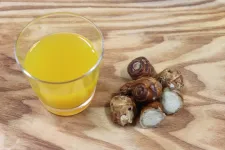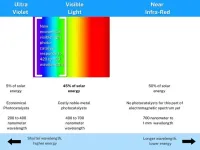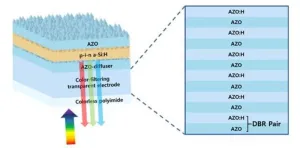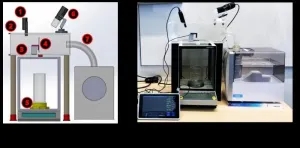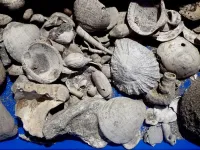(Press-News.org) How tomato plants defend themselves against a devastating ‘young’ Southern African virus has now been investigated at a molecular genetics level for the first time by researchers at the University of Johannesburg (UJ).
The Ty-1 gene is known to confer resistance to the well-known tomato yellow leaf curl virus (TYLCV). UJ researchers investigated what happens when tomato plants that harbour the Ty-1 gene are infected with the relatively unknown tomato curly stunt virus (ToCSV). They found a link between tolerance to ToCSV, a plant defence called viral DNA methylation, and Ty-1 gene activity.
The research is published in Frontiers in Plant Science.
To find out more about how that happens, they used lab techniques called bisulfite conversion and PCR amplification, coupled with a next-generation whole genome virus sequencing approach.
Young virus travelling
Many pathogens attack tomato plants, which produce the third biggest vegetable crop in the world, after potatoes and cassava.
Tomato curly stunt virus originated in South Africa about 30 years ago and is spread by whitefly. The virus can destroy an entire tomato crop, especially if enough plants are infected at a young stage. It has been found in neighbouring country Mozambique also.
The young tomato curly stunt virus (ToCSV) is similar to the established tomato yellow leaf curl virus (TYLCV) at the DNA level.
But relatively little is known about any ‘tools’ the tomato plants can use to defend themselves against ToCSV, says Dr Farhahna Allie, lead author on the study. Dr Allie is a researcher in the UJ Department of Biochemistry.
Trojan horse trick inside plants
Viruses have been attacking plants since the dawn of time. But they still have to trick the plants, to replicate themselves and cause disease, says Dr Gerrit Koorsen, co-author on the study.
“Geminiviruses like ToCSV do not have the capacity to make copies of themselves, and then to spread elsewhere. They are completely reliant on the plant for that. The virus has to trick the plant into ‘thinking’ that the plant is making more of its own DNA.
“So the virus is like a Trojan Horse inside the plant. The plant is replicating viral DNA ‘without knowing it’, ‘taking care of the infection’ and spreading the disease caused by the virus,” he says.
Attacking DNA inside the virus
In the ongoing battle between plants and viruses, plants ‘have discovered’ that it is very effective to focus their counter-attack on the DNA inside viruses.
For the study, the researchers used a variety of tomato that is susceptible to ToCSV, and another variety that can tolerate it.
The susceptible variety has a number of defences in its toolbox against other pathogens, but it cannot overcome ToCSV, says Allie. ToCSV can fully infect this variety.
Studying the way in which plants respond to a new virus like ToCSV is crucial to identifying ways of breeding resistant crops.
Resistance gene Ty-1
“The tolerant tomato variety has a similar genetic background to the susceptible variety, but it is better at switching on the Ty-1 resistance gene, which the susceptible variety struggles to do,” says Allie.
“The Ty-1 gene is known to be the major resistance gene in tomatoes against tomato yellow leaf curl virus (TYLCV). The ‘young’ virus ToCSV is similar to the TYLCV in terms of its genome, and Ty-1 may therefore well be responsible for tolerance or resistance against ToCSV too.
“As a first step to explore the link between resistance and tolerance and the Ty-1 gene, we wanted to see whether the tolerant plant uses the DNA methylation ‘tool’ to combat tomato curly stunt disease,” she says.
Switching off viral DNA
“Imagine the DNA of one tomato curly stunt virus as a tiny rubber band,” says Koorsen. “When the whitefly feeds on the plant, the fly transfers thousands of these DNA rubber bands into the cells of the plant.
“Let’s compare a cell of a plant that is susceptible to ToCSV, with a cell of a tomato plant that can tolerate ToCSV to some extent. In the tolerant plant cell the Ty-1 gene is very active.
“Given the data we analysed in this study, we think Ty-1 activity may be linked to the ability of plants to tag specific areas on the viral DNA ‘rubber band’, and ‘switch them off’, so the virus cannot make more if itself inside the plant cell,” says Koorsen.
The ‘tags’ are methyl groups. Each methyl group is one carbon and three hydrogen atoms. The tags attach to C-G, C-H-H and C-H-G letter sequences on the viral DNA. The ‘tagging’ process is called methylation, a known defence mechanism in plants.
Over time, in a tolerant plant cell, one then sees more and more tags on critical parts of the viruses’ DNA, and the virus either stops replicating or replicates slowly. This is called epigenetic silencing caused by methylation.
Meanwhile in the susceptible plant cell, the Ty-1 resistance gene is less active. So the thousands of infecting viruses from the whitefly can replicate inside the plant cell. Over time, there are more and more viruses in the plant, and the plant becomes completely infected.
Speeding up defences
“We now have one part of the ‘tomato defence toolbox’. I’m excited to explore what other defence tools the tomato plants have and how the tools come together,” says Allie.
Because the battle between viruses and plants is never-ending, tomato curly stunt virus will eventually mutate, tomato plants will fight back, and emerging computational techniques will create new options in plant breeding, says Koorsen.
So far, the defences of one variety of tomato have been compared with that of another variety using standard statistical analyses, he adds.
Koorsen looks forward to exploring Machine Learning (ML) and emerging AI methods to compare tomato varieties also.
“I’m excited for how we can use those to gain more insight into plant defences, using
the gigabytes of biological data generated in studies like this,” he says.
###
Notes to editors:
Media pack
Hi resolution images (including photos used in video) are available at:
https://drive.google.com/drive/folders/1_dU3RUA3-zliVycnQegJCf6hSxtutJM8?usp=sharing
No login or registration needed on a computer.
END
First defence against devastating ToCSV tomato virus explored
2023-08-28
ELSE PRESS RELEASES FROM THIS DATE:
Sleep can be most restful for older adults when nighttime temperature range is between 68 to 77 °F, study finds
2023-08-28
New research finds that sleep can be most efficient and restful for older adults when nighttime bedroom ambient temperature ranges between 68 to 77 °F.
The authors observed an overall trend: a 5-10 % drop in sleep efficiency as the nighttime ambient temperature increases from 77°F to 86°F. Importantly, this research also reveals substantial between-individual differences in optimal bedroom temperature.
“These results highlight the potential to enhance sleep quality in older adults by optimizing home thermal environments and emphasizing the importance ...
New study reveals anti-cancer properties in Kencur ginger
2023-08-28
You may know it as an aromatic spice to add flavor to your dishes or as a soothing herbal remedy to use for upset stomachs, but researchers from Osaka Metropolitan University have uncovered promising findings that Kencur, a tropical plant in the ginger family native to Southeast Asia, possesses anti-cancer effects.
Led by Associate Professor Akiko Kojima of the Graduate School of Human Life and Ecology, the researchers demonstrated that Kencur extract and its main active component, ethyl p-methoxycinnamate (EMC), significantly suppressed cancer cell growth at the cellular and animal levels.
While previous studies on EMC indicated its anti-cancer potential by decreasing the expression ...
New type of visible-light responsive photocatalyst is efficient, stable and very economical
2023-08-28
A new type of versatile economical photocatalyst that harnesses the visible portion of the sunlight spectrum has been developed by researchers from the University of Johannesburg. It is simple to manufacture.
Currently, economical photocatalysts only ‘use’ the UV spectrum of sunlight.
The new photocatalyst harnesses about a third of the visible light spectrum.
The extremely stable, powder-form three-component photocatalyst is built from graphitic carbon (89% of mass), a modified calixarene (10%) and a niobium-containing MXene (1%).
Researchers at the University of Johannesburg have developed a new type of photocatalyst that harnesses the visible ...
Low cost, high efficiency, multiple colors at the same time!
2023-08-28
A research team led by Dr. Jung-dae Kwon from the Department of Energy & Electronic Materials at the Korea Institute of Materials Science(KIMS) has succeeded in realizing the world's first transparent thin-film solar cell on a flexible substrate that exhibits different reflective colours and does not significantly reduce solar cell's efficiency. KIMS is a government-funded research institute under the Ministry of Science and ICT.
This is a technology that achieves reflective colour only a single material by periodically incorporating hydrogen into zinc oxide material doped with aluminium, which is a transparent electrode, to induce a refractive index difference. ...
New guidance on take-home naloxone for community overdose responders
2023-08-28
New guidance aimed at helping standardize community overdose response and take-home naloxone kits across Canada is published in CMAJ (Canadian Medical Association Journal) https://www.cmaj.ca/lookup/doi/10.1503/cmaj.230128. The guidance is an important document to optimize the effectiveness of take-home naloxone to save lives.
The guidance was developed by a panel of experts, including people with lived experience of drug use and overdose response, front-line and harm-reduction workers, public health professionals, clinicians and academics with expertise in harm reduction across Canada. ...
Indigenous females face disparities in health care in Canada
2023-08-28
Indigenous females living "off reserve" face many disparities in health care access, use and unmet needs, found new research in CMAJ (Canadian Medical Association Journal) https://www.cmaj.ca/lookup/doi/10.1503/cmaj.221407.
The study included 2902 First Nations, 2345 Métis, 742 Inuit and 74 760 non-Indigenous females of reproductive age (aged 15–55 years) obtained from the Canadian Community Health Survey from 2015 to 2020, including 4 months during the COVID-19 pandemic.
"We found that ...
Researcher finds inspiration from spider webs and beetles to harvest fresh water from thin air
2023-08-28
A team of researchers is designing novel systems to capture water vapour in the air and turn it into liquid.
University of Waterloo professor Michael Tam and his PhD students Yi Wang and Weinan Zhao have developed sponges or membranes with a large surface area that continually capture moisture from their surrounding environment.
Traditionally, fresh water for consumption is collected from rivers, lakes, groundwater, and oceans (with treatment). The current technologies Dr. Tam is developing are inspired by nature to harvest water from alternative sources as the world is facing ...
UEA researchers develop new tool to reduce stroke risk
2023-08-28
Peer reviewed – observational study - humans
Researchers at the University of East Anglia have developed a new way of identifying patients at risk of an irregular heartbeat, known as ‘atrial fibrillation’.
While not life threatening, the condition increases people’s risk of having a transient ischaemic attack (TIA) or stroke by up to five times.
A new study, published today, reveals four specific factors that can predict which patients will have atrial fibrillation.
These include older age, higher diastolic blood pressure and problems with both the coordination ...
No evidence grammar school systems are best for the brightest, study of 500,000 pupils reveals
2023-08-28
The UK’s brightest pupils’ chances of getting top GCSE grades are actually lower in grammar schools than in comprehensives, according to a major new piece of research.
The study, which was based on test results and other information from all pupils in England, challenges the common belief that high achievers do better in more academic schools.
Findings, published in the peer-reviewed journal Educational Review, demonstrate those with the highest scores at age 11 were less likely to achieve ...
Auckland wastewater pipe dig reveals 'fossil treasure trove'
2023-08-27
A new New Zealand Journal of Geology and Geophysics paper out today describes the 266 fossil species as one of the richest and most diverse groups of three-million-year-old fauna ever found in New Zealand. At least ten previously unknown species will be described and named in future research.
Fossil treasure trove from Auckland’s Mangere Wastewater Treatment Plant
In 2020, when Auckland’s Watercare were excavating two huge vertical shafts for a major upgrade of the major pipeline that brings raw sewage for treatment from the central city they dug through an ancient shell bed. Auckland paleontologist Bruce Hayward likened ...
